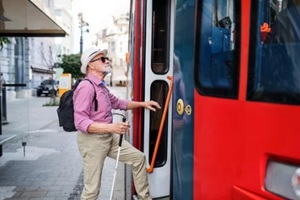 Transportation is an important part of anyone’s life at any age. From going to the store for essential groceries to being on time for doctor’s appointments and even attending family events, transportation is the center of it all. Age should not be a factor in whether a person can get to the places they need to go.
Transportation is an important part of anyone’s life at any age. From going to the store for essential groceries to being on time for doctor’s appointments and even attending family events, transportation is the center of it all. Age should not be a factor in whether a person can get to the places they need to go.
However, older folks (especially those facing physical and cognitive challenges) and their families need to be able to rely on local transit options. A senior citizen transportation plan created by community leaders makes transportation accessible, but it must be crafted with care.
The risks of a poorly implemented transportation plan can be dire. If the community does not provide consistent quality in transportation or adjust for accessibility, aging adults may not be able to perform the tasks necessary to thrive. They may even be harmed while trying to get to where they need to go.
Here is how to create an age-friendly transportation plan for your community to support older adults as they live and flourish.
What Makes a Senior Citizen Transportation Plan Age-Friendly
An age-friendly transportation plan should be created with people of all ages and walks of life in mind. Able-bodied, middle-aged adults should not be the only people for whom the transit system makes sense and is accessible. Here are some strategies to create age-friendly transportation.
Clearly posted transit times
Older adults cannot wait outside for an indeterminate amount of time. Whether the weather is problematic (no one wants to sit in the snow!) or a caregiver only has a certain amount of time available, waiting with no clear indication of when the next transit service will arrive can keep some people from using it.
Clearly post transit times, such as bus stop timing or train arrival timetables, to help people plan ahead without missing their transport or waiting too long without support. These timetables should be easy to read, and the posted location should be kept clean and located in a safe place.
Multiple transportation options
Not all individuals will be able to use all transit options. For instance, a person with a walker may struggle to navigate a train station with all of its staircases (or steep vertical ramps) and textured blocks along the train platform. Communities should make multiple options available so individuals can select the one that is most feasible for them. Taxis, buses, trains, and private vans are just some of the many options.
Accessible vehicles

Even if multiple transportation options are available, users will not get very far if they cannot access these rides. Accessible vehicles should be provided (even if they are on their own schedule separate from main-line transit). What makes a vehicle accessible varies depending on the type of transport, but options include handrails, appropriate storage for wheelchairs and other assistive devices, ramps, and priority seating.
A wide service area
It does no good for a community to create accessible, on-time transit options if they are located only in the center of town. Transit that is truly age-friendly should reach as far as possible so that even those in the suburbs and rural areas still have some options if they need them. While a bus line cannot run down every street, communities should make the extra effort to reduce the distance anyone must travel to access transportation.
Safety at pickup and drop-off
One of the most important elements of age-friendly transportation is keeping its use safe, both at pick-up and drop-off. Some considerations for increasing the safety of a transportation system include:
- Creating an enclosed waiting area to shield from extreme temperatures and weather conditions (e.g., ice, slippery wet leaves)
- Method of payment so that older adults with arthritis or movement and cognitive challenges do not have to count coins or perform other fine motor skills
- Priority seating to reduce the distance a person must walk if they need assistance
Make Senior Citizen Transportation More Accessible
 Transportation is a large part of what helps people to flourish. Older adults who still have access to essential medical appointments, grocery shopping for fresh ingredients, and social opportunities stay healthier and live longer than those who are confined to their homes and isolated. Explore the age-friendly transportation changes your community can make to bring more accessibility to the adults who deserve greater access.
Transportation is a large part of what helps people to flourish. Older adults who still have access to essential medical appointments, grocery shopping for fresh ingredients, and social opportunities stay healthier and live longer than those who are confined to their homes and isolated. Explore the age-friendly transportation changes your community can make to bring more accessibility to the adults who deserve greater access.
Contact us to discover how the Shepherd’s Center of Northern Virginia is making a difference in communities like Oakton, Vienna, Dunn Loring-Merrifield, Great Falls, Herndon, and Reston. If you’re outside these areas but have questions, give us a call, and we’ll guide you to the Shepherd’s Center nearest to you!
